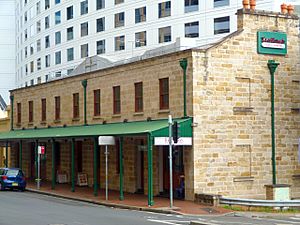121-127 Sussex Street, Sydney facts for kids
Quick facts for kids 121-127 Sussex Street |
|
|---|---|

121-127 Sussex Street, Sydney
|
|
| Location | 121-127 Sussex Street, Sydney central business district, City of Sydney, New South Wales, Australia |
| Built | 1850 |
| Owner | Property NSW |
| Official name: Building; Shops/Warehouses | |
| Type | State heritage (built) |
| Designated | 2 April 1999 |
| Reference no. | 412 |
| Type | Other - Commercial |
| Category | Commercial |
| Lua error in Module:Location_map at line 420: attempt to index field 'wikibase' (a nil value). | |
The building at 121-127 Sussex Street in Sydney is a very old and important building. It used to be a warehouse where goods were stored. Now, it's a modern office building. It was built way back in 1850. You can find it on Sussex Street in the heart of Sydney's city centre. This historic place is owned by Property NSW, which is a part of the Government of New South Wales. Because it's so special, it was added to the New South Wales State Heritage Register on April 2, 1999.
Contents
What is the History of 121-127 Sussex Street?
This building tells a story about Sydney's past. In the mid-1800s, the area around Sussex Street was busy with trade. Many buildings there were used for storing goods and as markets. This was because they were very close to the Darling Harbour wharves, where ships brought in all sorts of products.
Who Used the Building in the Past?
For a long time in the 1800s and early 1900s, this building was home to businesses that bought and sold farm products. These were called "produce and commission agents." Imagine a bustling place filled with fruits, vegetables, and other goods!
Other types of businesses also used the building. For example, a photographer had a studio here in the 1870s. A company called Nipper and See stayed for many years. They were not just produce agents but also held auctions.
Later, several Farmers Co-operative Associations used the warehouses and offices. These groups helped farmers sell their goods. In the 1890s, a big company called Goldsbrough Mort & Co had "sampling rooms" here. This is where they would show samples of wool to buyers.
How Did the Building Change Over Time?
Just before Australia became a federation (when the states joined together), the buildings were changed or rebuilt. They became a mix of warehouses and business offices. For a short time, a tinsmith and canister maker worked here.
In the early 1900s, well-known produce merchants Livingstone and Gray (later Livingstone and Basham) had their business here for many years. This shows how important the building was for Sydney's trade.
In 1985, the site was completely redeveloped. It became part of the Four Points Hotel. As of 2018, the property was leased by Multiplex, a large construction and development company.
What Does 121-127 Sussex Street Look Like?
The building was built around the 1850s. It has painted stone walls and an iron roof. Originally, it was one storey high facing Sussex Street, but it had four storeys at the back.
Around the time of Federation, a second storey was added to the front. This new part was designed to match the original building. The large openings on the ground floor show that it was used for commercial purposes, like shops or warehouses. The first floor addition also shows how successful the businesses there were.
Why is 121-127 Sussex Street Important?
This building is considered important for a few reasons. It's a great example of an early Victorian commercial building. It also fits in well with the other historic buildings on Sussex Street.
What Does it Show About History?
The building has historical importance because it was connected to many well-known produce and wool merchants. It helps us understand how trade and business worked in Sydney long ago.
Why is its Design Special?
As part of the Sussex Street group of buildings, it adds a lot to the look and feel of the street. Its design, with the large openings and the matching second storey, shows good architectural style from its time.

